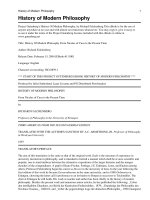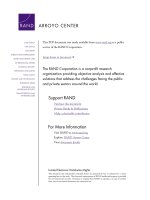A RUSH OF BLOOD TO THE HEAD
Bạn đang xem bản rút gọn của tài liệu. Xem và tải ngay bản đầy đủ của tài liệu tại đây (168.73 KB, 21 trang )
buy.OLOGY
Designed by Trung Pham Tuan
- 11 -
1
A RUSH OF BLOOD
TO THE HEAD
The Largest Neuromarketing
Study Ever Conducted
NOT SURPRISINGLY, THE
smokers were on edge, fidgety, not sure what to expect.
Barely noticing the rain and overcast skies, they clumped together outside the
medical building in London, England, that houses the Centre for NeuroImaging
Sciences. Some were self-described social smokers—a cigarette in the morning,
a second snuck in during lunch hour, maybe half-a-dozen more if they went
out carousing with their friends at night. Others confessed to being longtime
two-pack-a-day addicts. All of them pledged their allegiance to a single brand,
whether it was Marlboros or Camels. Under the rules of the study, they knew
they wouldn’t be allowed to smoke for the next four hours, so they were busy
stockpiling as much tar and nicotine inside their systems as they could. In
between drags, they swapped lighters, matches, smoke rings, apprehensions:
Will this hurt? George Orwell would love this. Do you think the machine will
be able to read my mind?
Inside the building, the setting was, as befits a medical laboratory, antiseptic,
no-nonsense, and soothingly soulless—all cool white corridors and flannel gray
doors. As the study got under way I took a perch behind a wide glass window
inside a cockpit-like control booth among a cluster of desks, digital equipment,
three enormous computers, and a bunch of white-smocked researchers. I was
looking over a room dominated by an fMRI (functional Magnetic Resonance
Imaging) scanner, an enormous, $4 million machine that looks like a giant
sculpted doughnut, albeit one with a very long, very hard tongue. As the most
advanced brain-scanning technique available today, fMRI measures the
magnetic properties of hemoglobin, the components in red blood cells that
carry oxygen around the body. In other words, fMRI measures the amount of
oxygenated blood throughout the brain and can pinpoint an area as small as one
millimeter (that’s 0.03937 of an inch). You see, when a brain is operating on a
specific task, it demands more fuel—mainly oxygen and glucose. So the harder
a region of the brain is working, the greater its fuel consumption, and the
buy.OLOGY
Designed by Trung Pham Tuan
- 12 -
greater the flow of oxygenated blood will be to that site. So during fMRI, when
a portion of the brain is in use, that region will light up like a red-hot flare. By
tracking this activation, neuroscientists can determine what specific areas in
the brain are working at any given time.
Neuroscientists traditionally use this 32-ton, SUV-sized instrument to
diagnose tumors, strokes, joint injuries, and other medical conditions that
frustrate the abilities of X-rays and CT scans. Neuropsychiatrists have found
fMRI useful in shedding light on certain hard-to-treat psychiatric conditions,
including psychosis, sociopathy, and bipolar illness. But those smokers puffing
and chatting and pacing in the waiting room weren’t ill or in any kind of
distress. Along with a similar sample of smokers in the United States, they were
carefully chosen participants in a groundbreaking neuromarketing study who
were helping me get to the bottom—or the brain—of a mystery that had been
confounding health professionals, cigarette companies, and smokers and
nonsmokers alike for decades.
For a long time, I’d noticed how the prominently placed health warnings on
cigarette boxes seemed to have bizarrely little, if any, effect on smokers.
Smoking causes fatal lung cancer. Smoking causes emphysema. Smoking while
pregnant causes birth defects. Fairly straightforward stuff. Hard to argue with.
And those are just the soft-pedaled American warnings. European cigarette
makers place their warnings in coal-black, Magic Marker–thick frames, making
them even harder to miss. In Portugal, dwarfing the dromedary on Camel
packs, are words even a kid could understand: Fumar Mata. Smoking kills. But
nothing comes even close to the cigarette warnings from Canada, Thailand,
Australia, Brazil—and soon the U.K. They’re gorily, forensically true-to-life,
showing full-color images of lung tumors, gangrenous feet and toes, and the
open sores and disintegrating teeth that accompany mouth and throat cancers.
You’d think these graphic images would stop most smokers in their tracks. So
why, in 2006, despite worldwide tobacco advertising bans, outspoken and
frequent health warnings from the medical community, and massive
government investment in antismoking campaigns, did global consumers
continue to smoke a whopping 5,763 billion cigarettes, a figure which doesn’t
include duty-free cigarettes, or the huge international black market trade? (I
was once in an Australian convenience store where I overheard the clerk
asking a smoker, “Do you want the pack with the picture of the lungs, the
heart, or the feet?” How often did this happen, I asked the clerk? Fifty percent
of the time that customers asked for cigarettes, he told me.) Despite what is
buy.OLOGY
Designed by Trung Pham Tuan
- 13 -
now known about smoking, it’s estimated that about one-third of adult males
across the globe continue to light up. Approximately 15 billion cigarettes are
sold every day—that’s 10 million cigarettes sold a minute. In China, where
untold millions of smokers believe that cigarettes can cure Parkinson’s disease,
relieve symptoms of schizophrenia, boost the efficacy of brain cells, and
improve their performance at work, over 300 million people,
1
including 60
percent of all male doctors, smoke. With annual sales of 1.8 trillion cigarettes,
the Chinese monopoly is responsible for roughly one-third of all cigarettes
being smoked on earth today
2
—a large percentage of the 1.4 billion people
using tobacco, which, according to World Bank projections, is expected to
increase to roughly 1.6 billion by 2025 (though China consumes more cigarettes
than the United States, Russia, Japan, and Indonesia combined).
In the Western world, nicotine addiction still ranks as an enormous concern.
Smoking is the biggest killer in Spain today, with fifty thousand smoking-
related deaths annually. In the U.K., roughly one-third of all adults under the
age of sixty-five light up, while approximately 42 percent of people under sixty-
five are exposed to tobacco smoke at home.
3
Twelve times more British people
have died from smoking than died in World War II. According to the American
Lung Association, smoking-related diseases affect roughly 438,000 American
lives a year, “including those affected indirectly, such as babies born
prematurely due to prenatal maternal smoking and victims of ‘secondhand’
exposure to tobacco’s carcinogens.” The health-care costs in the United States
alone? Over $167 billion a year.
4
And yet cigarette companies keep coming up
with innovative ways to kill us. For example, Philip Morris’s latest weapon
against workplace smoking bans is Marlboro Intense, a smaller, high-tar
cigarette—seven puffs worth—that can be consumed in stolen moments in
between meetings, phone calls, and PowerPoint presentations.
5
It makes no sense. Are smokers selectively blind to warning labels? Do they
think, to a man or a woman, Yes, but I’m the exception here? Are they showing
the world some giant act of bravado? Do they secretly believe they are
immortal? Or do they know the health dangers and just not care?
That’s what I was hoping to use fMRI technology to find out. The thirty-two
smokers in today’s study? They were among the 2,081 volunteers from
America, England, Germany, Japan, and the Republic of China that I’d enlisted
for the largest, most revolutionary neuromarketing experiment in history.
buy.OLOGY
Designed by Trung Pham Tuan
- 14 -
It was twenty-five times larger than any neuromarketing study ever before
attempted. Using the most cutting-edge scientific tools available, it revealed the
hidden truths behind how branding and marketing messages work on the
human brain, how our truest selves react to stimuli at a level far deeper than
conscious thought, and how our unconscious minds control our behavior
(usually the opposite of how we think we behave). In other words, I’d set off on
a quest to investigate some of the biggest puzzles and issues facing consumers,
businesses, advertisers, and governments today.
For example, does product placement really work? (The answer, I found out,
is a qualified no.) How powerful are brand logos? (Fragrance and sound are
more potent than any logo alone.) Does subliminal advertising still take place?
(Yes, and it probably influenced what you picked up at the convenience store
the other day.) Is our buying behavior affected by the world’s major religions?
(You bet, and increasingly so.) What effect do disclaimers and health warnings
have on us? (Read on.) Does sex in advertising work (not really) and how could
it possibly get more explicit than it is now? (You just watch.)
Beginning in 2004, from start to finish, our study took up nearly three years
of my life, cost approximately $7 million (provided by eight multinational
companies), comprised multiple experiments, and involved thousands of
subjects from across the globe, as well as two hundred researchers, ten
professors and doctors, and an ethics committee. And it employed two of the
most sophisticated brain-scanning instruments in the world: the fMRI and an
advanced version of the electroencephalograph known as the SST, short for
steady-state typography, which tracks rapid brain waves in real time. The
research team was overseen by Dr. Gemma Calvert, who holds the Chair in
Applied Neuroimaging at the University of Warwick, En gland, and is the
founder of Neurosense in Oxford, and Professor Richard Silberstein, the CEO of
Neuro-Insight in Australia. And the results? Well, all I’ll say for now is that
they’ll transform the way you think about how and why you buy.
MARLENE, ONE OF
the smokers in the study, took her place lying flat on her back inside the fMRI.
The machine made a little ticking sound as the platform rose and locked into
place. Marlene looked a little hesitant—who wouldn’t?—but managed a gung-
buy.OLOGY
Designed by Trung Pham Tuan
- 15 -
ho smile as a technician placed the protective head coil over most of her face in
preparation for the first brain scan of the day.
From Marlene’s pretesting questionnaire and interview, I knew she was a
recently divorced mother of two from Middlesex, and that she’d started
smoking at boarding school fifteen years earlier. She thought of herself less as a
nicotine addict than a “party smoker,” that is, she smoked just a couple of
“small” cigarettes during the day, as well as eight to ten more at night.
“Are you affected by the warnings on cigarette packs?” the questionnaire had
asked.
“Yes,” Marlene had written, twirling her pen around in her fingers as though
she was about to ignite the thing.
“Are you smoking less as a consequence of these?”
Another yes. More pen-spinning. I’ve never been a smoker, but I felt for her.
Her interview answers were clear enough, but now it was time to interview
her brain. For those who’ve never had an MRI, it’s not what I’d call the most
relaxing or enjoyable experience in the world. The machine is clankingly noisy,
lying perfectly still is tedious, and if you’re at all prone to panic or
claustrophobia, it can feel as if you’re being buried alive in a phone booth. Once
inside, it’s best you remain in a state of yogic calm. Breathe. In, out, in again.
You’re free to blink and swallow, but you better ignore that itch on your left
calf if it kills you. A tic, a jiggle, a fidget, a grimace, body twitching—the
slightest movement at all and the results can be compromised. Wedding bands,
bracelets, necklaces, nose rings, or tongue studs have to be taken off
beforehand, as well. Thanks to the machine’s rapacious magnet, any scrap of
metal would rip off so fast you wouldn’t know what just belted you in the eye.
Marlene was in the scanner for a little over an hour. A small reflective
apparatus resembling a car’s rearview mirror projected a series of cigarette
warning labels from various angles, one after another, on a nearby screen.
Asked to rate her desire to smoke during this slideshow, Marlene signaled her
responses by pressing down on what’s known as a button box—a small black
console resembling a hand-sized accordion—as each image flashed by.
We continued to perform brain scans on new subjects over the next month
and a half.
buy.OLOGY
Designed by Trung Pham Tuan
- 16 -
Five weeks later, the team leader, Dr. Calvert, presented me with the results.
I was, to put it mildly, startled. Even Dr. Calvert was taken aback by the
findings: warning labels on the sides, fronts, and backs of cigarette packs had no
effect on suppressing the smokers’ cravings at all. Zero. In other words, all
those gruesome photographs, government regulations, billions of dollars some
123 countries had invested in nonsmoking campaigns, all amounted, at the end
of a day, to, well, a big waste of money.
“Are you sure?” I kept saying.
“Pretty damn certain,” she replied, adding that the statistical validity was as
solid as could be.
But this wasn’t half as amazing as what Dr. Calvert discovered once she
analyzed the results further. Cigarette warnings—whether they informed
smokers they were at risk of contracting emphysema, heart disease, or a host of
other chronic conditions—had in fact stimulated an area of the smokers’ brains
called the nucleus accumbens, otherwise known as “the craving spot.” This
region is a chain-link of specialized neurons that lights up when the body
desires something—whether it’s alcohol, drugs, tobacco, sex, or gambling.
When stimulated, the nucleus accumbens requires higher and higher doses to
get its fix.
In short, the fMRI results showed that cigarette warning labels not only
failed to deter smoking, but by activating the nucleus accumbens, it appeared
they actually encouraged smokers to light up. We couldn’t help but conclude
that those same cigarette warning labels intended to curb smoking, reduce
cancer, and save lives had instead become a killer marketing tool for the
tobacco industry.
Most of the smokers checked off yes when they were asked if warning labels
worked—maybe because they thought it was the right answer, or what the
researchers wanted to hear, or maybe because they felt guilty about what they
knew smoking was doing to their health. But as Dr. Calvert concluded later, it
wasn’t that our volunteers felt ashamed about what smoking was doing to their
bodies; they felt guilty that the labels stimulated their brains’ craving areas. It
was just that their conscious minds couldn’t tell the difference. Marlene hadn’t
been lying when she filled out her questionnaire. But her brain—the ultimate
no-bullshit zone—had adamantly contradicted her. Just as our brains do to each
one of us every single day.
buy.OLOGY
Designed by Trung Pham Tuan
- 17 -
The results of the additional brain scan studies I carried out were just as
provocative, fascinating, and controversial as the cigarette research project. One
by one, they brought me closer to a goal I’d set out to accomplish: to overturn
some of the most long-held assumptions, myths, and beliefs about what kinds of
advertising, branding, and packaging actually work to arouse our interest and
encourage us to buy. If I could help uncover the subconscious forces that
stimulate our interest and ultimately cause us to open our wallets, the brain-
scan study would be the most important three years of my life.
BY WAY OF
profession, I’m a global branding expert. That is, it’s been a lifelong mission
(and passion) to figure out how consumers think, why they buy or don’t buy
the products they do—and what marketers and advertisers can do to pump new
life into products that are sick, stuck, stumbling, or just lousy to begin with.
If you look around, chances are pretty good you’ll find my branding
fingerprints are all over your house or apartment, from those products under
the kitchen sink, to the chocolate you stash in your desk drawer, to the phone
beside your bed, to the shaving cream in your bathroom, to the car sitting in
the driveway. Maybe I helped brand your TV’s remote control. The coffee you
gulped down this morning. The bacon cheeseburger and French fries you
ordered in last week. Your computer software. Your espresso machine. Your
toothpaste. Your dandruff shampoo. Your lip balm. Your underwear. Over the
years I’ve been doing this work, I’ve helped brand antiperspirant, feminine
hygiene products, iPod speakers, beer, motorcycles, perfume, Saudi Arabian
eggs—the list goes on and on. As a branding expert and brand futurist (meaning
that the sum of my globe-hopping experience gives me a helicopter view of
probable future consumer and advertising trends), businesses consider my
colleagues and me something of a brand ambulance service, a crisis-
intervention management team.
Let’s say that your line of pricey bottled water from the Silica-Filled-Crystal-
Clear-Mountain-Streams-and-Artesian-Wells-of-Wherever is tanking. The
company wants consumers to believe it’s bottled by elves standing ankle-deep
in fjords rather than inside a sprawling plant off the New Jersey Turn-pike, but
regardless, its market shares are tumbling, and no one in the company knows
what to do. I’ll begin digging. What’s the secret of their product? What makes
buy.OLOGY
Designed by Trung Pham Tuan
- 18 -
it stand out? Are there any stories or rituals or mysteries consumers associate
with it? If not, can we root around and find some? Can the product somehow
break through the two-dimensional barrier of advertising by appealing to
senses the company hasn’t yet thought of? Smell, touch, sound? A gasp the cap
makes when you unscrew it? A flirty pink straw? Is the advertising campaign
edgy and funny and risk-taking, or is it as boring and forgettable as every other
company’s?
Because I travel so much, I’m able to see how brands perform all over the
world. I’m on an airplane about three hundred days out of the year, giving
presentations, analyses, and speeches. If it’s Tuesday, I could be in Mumbai. The
next day São Paolo. Or Dublin, Tokyo, Edinburgh, San Francisco, Athens, Lima,
Sri Lanka, or Shanghai. But my hectic travel schedule is an advantage I can
bring to a team that’s usually too busy to go outside their own building for
lunch, much less visit a store in Rio de Janeiro or Amsterdam or Buenos Aires
to observe their product in action.
I’ve been told more times than I can count that my appearance is as
nonconventional as what I do for a living. At thirty-eight, I stand about five
feet eight inches, and am blessed, or cursed, with an extremely young, boyish-
looking face. The excuse I’ve come up with over the years is that I grew up in
Denmark, where it was so cold all the time the weather froze my looks in place.
My features, my raked-back blond hair, and my habit of wearing all black give
a lot of people the impression that I’m some kind of quirky child evangelist, or
maybe some precocious, slightly wired high-school student who got lost on the
way to the science lab and ended up in a corporate boardroom by mistake. I’ve
gotten used to this over the years. I suppose you could say that it’s evolved into
my brand.
So how did I find myself staring through a window into an antiseptic medical
lab in a rain-soaked English university as one volunteer after another submitted
to an fMRI brain scan?
By 2003, it had become pretty clear to me that traditional research methods,
like market research and focus groups, were no longer up to the task of finding
out what consumers really think. And that’s because our irrational minds,
flooded with cultural biases rooted in our tradition, upbringing, and a whole lot
of other subconscious factors, assert a powerful but hidden influence over the
choices we make. Like Marlene and all those other smokers who said that
cigarette warnings discouraged them from smoking, we may think we know









![broken markets [electronic resource] a user's guide to the post-finance economy](https://media.store123doc.com/images/document/14/y/kz/medium_kzd1401381668.jpg)